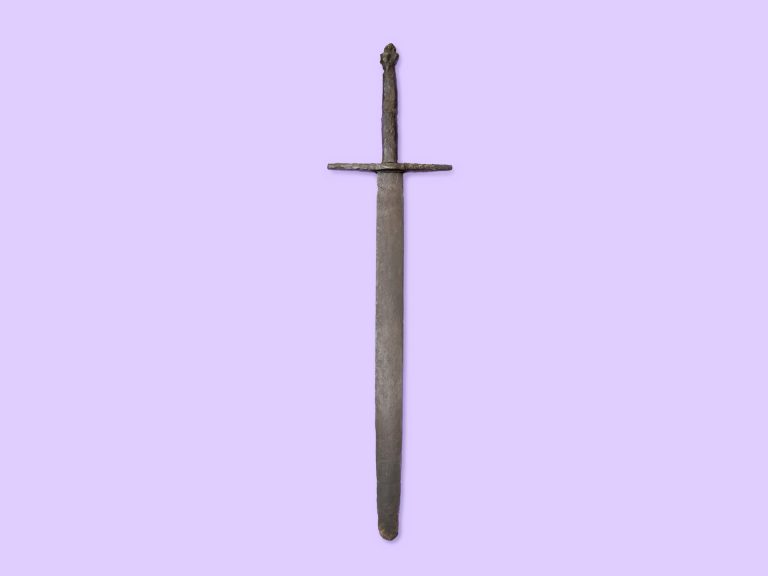A European cavalryman’s helmet modelled on an oriental design
Die Zischägge entwickelte sich im Laufe des 17. Jahrhunderts zu einem der typischen Reiterhelme in Europa. Der Name Zischägge stammt vom Chichak, einen im Aufbau ähnlichen osmanischen Prunkhelm, der als Vorbild diente. Von dort aus tauchte der Helm im 16. Jahrhundert als sisak in Südosteuropa bei den Husaren und als szyszak in Polen auf.
The helmet on display in the Deutschlandmuseum is a classic 17th-century Zischägge. Apart from its well-preserved leather lining, the helmet is made entirely of metal. Whilst the short eye shield prevented injuries to the face from sword blows that had been deflected by the round form of the helmet, a curved nose iron protected the lower face.
This could be adjusted vertically to fit the wearer, and fixed in position with a screw. A long neck guard with multiple interlocking plates known as the lobster tail protected the wearer’s neck, and two lateral metal wings incorporating an aperture protected the ears whilst enabling the wearer to hear.

Cuirassier units wearing Zischägge at the siege of Bautzen in 1620, copperplate engraving by Matthäus Merian (source: public domain, via Wikimedia Commons)
The Zischägge was standard issue for units of heavy cavalry known as cuirassiers, named for the heavy iron breast plate, or cuirass, that they wore. Although the Zischägge used by each European army varied in some way, their essential design remained the same. Changes in military practice led to the abandonment of this type of helmet from the late 17th century onwards.
Pappenheim and the Zischägge in the Thirty Years’ War
The European lobster-tailed pot helmet was known by various names, including the Pappenheimer helmet. Gottfried Heinrich von Pappenheim (1594–1632) was a Catholic general and commander of the cavalry forces of the Holy Roman Empire, who served under the supreme command of Wallenstein. The courage and loyalty of the Pappenheimer was expressed in the widespread saying, “I know my Pappenheimer”. A modified version of this dictum even made it into the text of Friedrich Schiller’s drama Wallenstein’s Death and has since become a popular contemporary expression, although with a slightly less positive meaning.

The Zischägge on display in the exhibition at the Deutschlandmuseum is more than just an artefact from the Thirty Years’ War. The survival of its namesake into modern parlance – through a romantic drama still read and performed today – creates a narrative arc from the crucible of modern German history to our contemporary world, highlighting the role of the past in shaping the future.
Property information
Designation
- Date 17th century
- Gallery The Reformation
- Category Headgear
- Origin Germany
- Dimensions 21 x 25 x 39 cm (WxHxD)
- Material Leder, metal
Property information
Designation
- Datierung 17th century
- Epochenraum The Reformation
- Kategorie Headgear
- Herkunft Germany
- Dimensionen 21 x 25 x 39 cm (WxHxD)
- Material Leder, metal

About the Deutschlandmuseum
An immersive and innovative experience museum about 2000 years of German history
Reading tips and links
Lifesaver? The German Steel Helmet in the First World War
German Tank Museum Munster
Lifesaver? The German Steel Helmet in the First World War
German Tank Museum Munster
Share article
Other objects in this collection
Discover history

2000 years
12 epochs
1 hour




